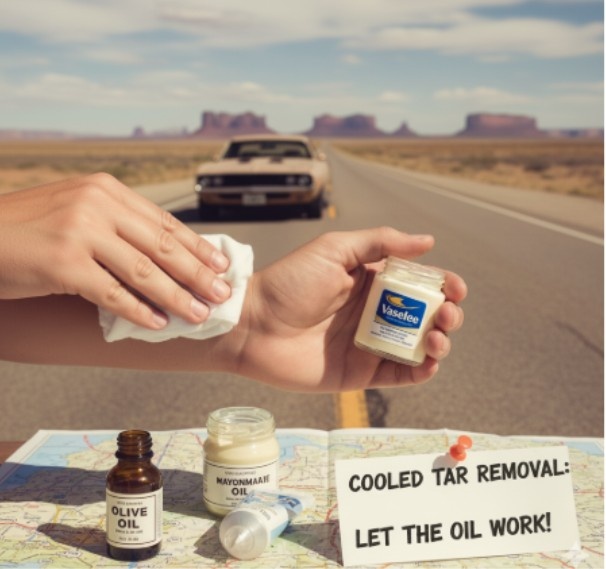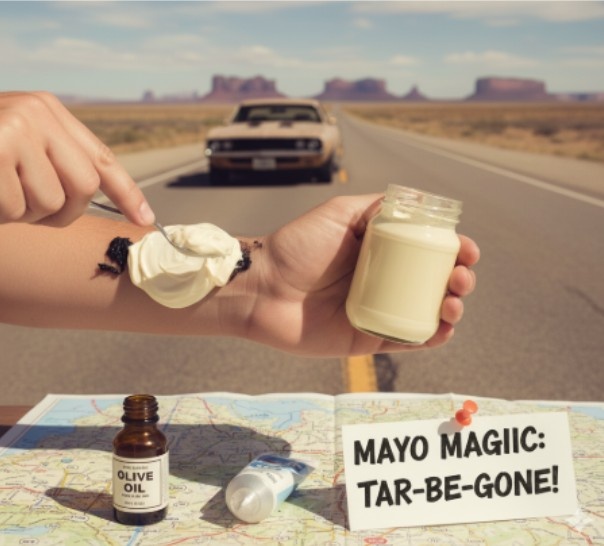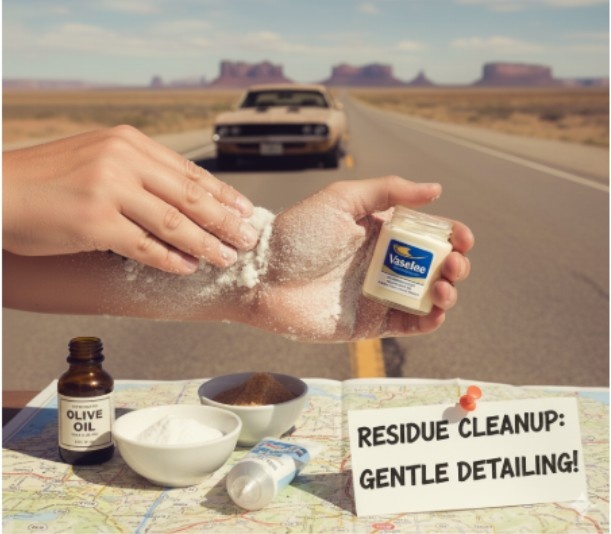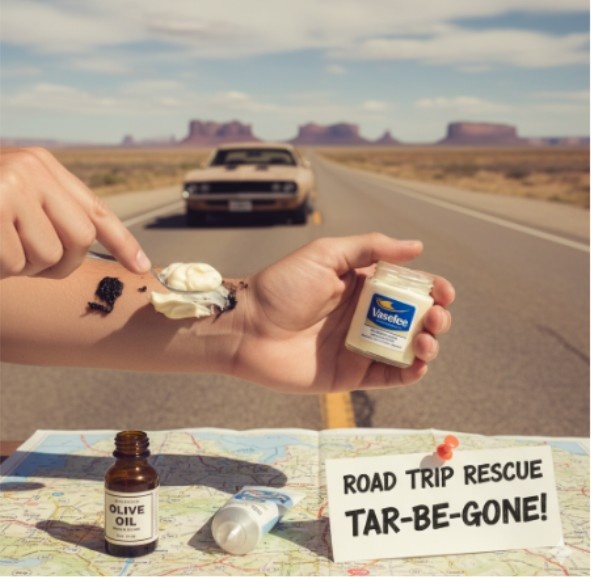I’ve spent more than half my life behind the wheel, crisscrossing highways from the misty coasts of Oregon to the sunbaked backroads of Arizona.
Asphalt has been my best friend and my worst enemy. One summer in Texas, I leaned on a fresh guardrail during a roadside tire check—didn’t notice the black streaks until my arm felt like it had been dipped in glue.
That was the day I learned how to get tar off skin without going mad or peeling my own hide off like a sunburn.
If you’ve ever had that sticky black stuff hitch a ride on your hands, legs, or elbows, trust me: there’s a smarter way than scrubbing until you see stars.
Let’s talk about how to handle it like someone who’s been down this road before—literally.
What Should You Do First if the Tar Is Hot?
Hot tar is no joke. It’s not just sticky—it can burn. I’ve seen it splatter off truck tires on scorching asphalt and land on unsuspecting bystanders. If this happens, treat it as a burn before anything else.
Run cool (not icy) water over the area for at least 20 minutes. This slows down the heat damage and keeps the tar from sinking deeper into your skin. Do not try to pull or scrape it while it’s hot. You’ll risk taking skin with it.
And if it’s near your eyes, covering a large area, or blistering—skip the home remedies and head straight to a doctor.
Road warrior wisdom says: it’s better to be patched up by a pro than to push your luck and end up with a scar shaped like Interstate Highway System signage.
How Do You Get Cooled Tar Off Skin?

Once the tar has cooled, it becomes more of a stubborn nuisance than a danger. This is where you can win the battle with patience and the right tools from your own kitchen.
I’ve always kept a tiny tub of Vaseline in my glovebox. It’s not just for dry lips in the desert air—it’s a secret weapon against tar. Slather a thick layer over the tar-covered skin.
You can also use baby oil, olive oil, or even mayonnaise (yes, the sandwich kind). Cover it well, then give it time—at least 20 to 30 minutes. The goal is to let the oil break down the tar’s grip so it releases without a fight.
Once it’s softened, gently wipe it off with a soft cloth or paper towel. You might have to repeat the process a couple of times, but it beats rubbing your skin raw.
Can Mayonnaise Really Remove Tar?

The first time I saw a biker buddy crack open a jar of mayo on the roadside, I thought he’d lost his marbles. But you know what? It works.
Mayonnaise is packed with oil, and oil is the magic key to breaking down tar. Just spread a generous layer over the sticky patch, let it sit for about 30 minutes, and then gently wipe it away. It feels weirdly fancy—like giving your arm a picnic—but it gets the job done.
Don’t forget to wash the area afterward with soap and warm water. Otherwise, you’ll be explaining to your travel buddies why you smell like a deli counter.
What If the Tar Has Hardened?
Sometimes you don’t even notice the tar until it’s dry, black, and crusty. This is when a cold trick comes in handy—literally.
Rub an ice cube or ice pack over the tar until it becomes brittle. The cold makes it crack, which lets you carefully peel off chunks without tugging on your skin. If it starts to soften again, reapply the ice until it’s hard enough to flake off.
This method saved my boots once in New Mexico after stepping on a tar patch during a roadside photo op. Nothing feels better than seeing the chunks pop off like brittle candy.
How Do You Clean Up Residue After Removing Tar?

Even after the big chunks are gone, you’ll often see stubborn smudges or feel a tacky layer. This is when you go from “roadside medic” to “gentle detailer.”
Wash the area thoroughly with mild soap and warm water. If residue lingers, make a baking soda paste and rub gently in circular motions.
You can also try a sugar and olive oil scrub—bonus: it leaves your skin soft. For feet or heels, a pumice stone works wonders, but go easy to avoid irritation.
When you’re done, rinse well and apply a soothing moisturizer. Your skin just survived a sticky ordeal; it deserves some love.
Why Should You Avoid Harsh Solvents?
Out on the road, I’ve heard some wild advice—like using gasoline or nail polish remover to dissolve tar. Don’t.
Those chemicals can burn your skin, cause rashes, and absorb into your bloodstream. They might melt tar, but they’ll also melt your skin barrier.
The beauty of using oils or mayonnaise is that they’re safe and gentle. You’ll get rid of the tar without adding a chemical burn to your list of travel memories.
Tar Removal Methods Compared
| Method | What You Need | How It Works | Best For | Time Needed |
| Oil-Based Products | Baby oil, olive oil, coconut oil, or | Oils break down tar’s sticky bond, allowing it to wipe off easily | Large or sticky patches | 20–30 minutes soak |
| Mayonnaise | Plain mayonnaise | Oil content softens tar, similar to cooking oils | Smaller patches, arms/hands | 30 minutes soak |
| Ice Method | Ice cubes or an ice pack | Cold makes tar brittle so it cracks and flakes off | Hardened or crusty tar spots | 5–10 minutes |
| Baking Soda Paste | Baking soda + water | Gentle exfoliation lifts lingering residue | Thin residue after oil/mayo use | 5 minutes scrub |
| Sugar Scrub | Sugar + olive oil | Mild abrasive action removes leftover stains | Stubborn tar stains, soft skin | 5 minutes scrub |
| Pumice Stone | Pumice stone (used gently) | Light abrasion scrubs off stuck bits | Tar on feet or thick skin areas | 2–3 minutes light use |
FAQ: Real Questions About How to Get Tar Off Skin
1. Can I just scrub the tar off with soap and water?
Not really. Tar is hydrophobic, which means water won’t break it down. You’ll end up scrubbing too hard and hurting your skin. Always start with an oil-based product to loosen it before washing.
2. What if the tar is stuck in my arm hair or leg hair?
Coat the area with oil and let it sit longer—about 30 to 40 minutes. This softens the tar enough that you can wipe it away without ripping out hair. Be patient, and avoid yanking it off in one go.
3. Can I use butter if I don’t have oil or petroleum jelly?
Yes, in a pinch. Butter is fatty enough to break down tar, though it’s messier and smells stronger. Just don’t use salted butter—it can sting if your skin is irritated.
4. How do I know if I need a doctor?
See a doctor if you notice blistering, burns, severe pain, or if the tar is near your eyes. Also get help if the tar covers a large area or won’t come off after several attempts. It’s better to get checked than to risk infection.
Rolling Away Clean: My Final Roadside Wisdom
Getting tar on your skin might feel like a road trip disaster, but it doesn’t have to end that way. With patience, the right products, and a gentle touch, you can get back to your journey without missing a mile.
Whenever I see a fresh stretch of blacktop now, I smile—and keep my elbows off the guardrails. Because the real trick isn’t just knowing how to get tar off skin… it’s avoiding it in the first place.
Stay safe, stay clean, and keep the wheels turning.






